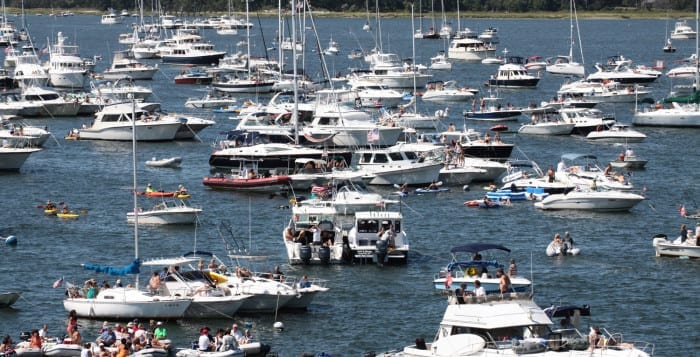Boater safety tips ahead of Labor Day weekend

By Herb Herman
It’s Labor Day weekend and a great time to go boating. You get the family in the car and go to the marina. Being a responsible boater, first you check the weather forecast and make sure that you won’t face any surprises out on the water. You or someone else will remember the sandwiches and drinks. You get to the boat and go through the required check-off items: examine the fuel level; check oil; see that the personal flotation devices are in the right place — at least one per person and easily accessible in an emergency — check if the anchor is set up for easy deployment; that flares and other emergency items in order; that the hand-held VHF radio is charged and readily available.
Items to check for as you head out to sea
•Personal Flotation Devices — at least one per person on board
•First Aid Kit and blanket
•Very high frequency radio
•Flashlight
•Operational navigational lights
•Depth sounder, lead line, sounding pole
•Bilge pump or other de-watering device, portable pump
•Serviceable and sufficient number of fire extinguishers — should be tested occasionally
•Watch or clock
•Visual distress signal
•Sound-producing device
•Compass
•Chart for operating area
•Deviation tables
•Navigational tools
•Binoculars
•Tide tables
•Adequate fenders
•Anchor and anchor line (rode)
•Boat hook
•Cleats in order — sufficient strength — through hulls
•Tools for emergency repairs
Being a responsible boater, the final thing to do before you cast off is to inform the passengers and crew as to where the emergency items are and how to use and wear them. And if you are a diligent boater, you file a float plan with friends, so that in the eventuality that you aren’t where you’re supposed to be in the coming days, they can inform the Coast Guard of a potential problem.
All of the above seems like a lot of hard work to go out for a day trip to the local anchorage. But with some experience, and perhaps after some nasty events, you will tend to do these things automatically — better yet, have an actual check-off list so you forget nothing. Then you’ll have a beautiful day to go boating.
Coast Guard teaches, rather preaches, to their boat crews and to the Coast Guard Auxiliary situational awareness. That is, what’s going on around you. In the parlance of the local guru, mindfulness — the state of knowing the environment in which your boat plows ahead. These include water state, weather now and what’s to come, wind, other boats and buoys and all the impediments that exist on local waters. There should also be a designated lookout in case someone falls overboard.
Above all, know the rules of the road. This includes what to do when boats approach one another. These regulations, also known as colregs, are devised to avoid collisions at sea. The main elements should be learned by way of courses given on Nautical charts, which are available for the waters in which you wish to sail. The chart, unlike a land road map, gives you broad swaths of safe passages and also tells you which regions to avoid due to shallow depths and rocks.
If you’re a power boater or a sailor with an accessory motor, you should know about the innards of the beast. Have you enough fuel for your planned voyage? Will you check the oil dipstick, or do you assume marina personnel do it for you? They won’t unless you ask them to. Are all your oil, water, fuel and water filters clean, and can you change out a clogged filter? Are water cooling sea cocks open? Can you troubleshoot easy problems? Do you have the essential tools for such work? Most aspects of inboard and outboard motors can be handled by a layman with a little study. A quick course on troubleshooting your power plant by the marina mechanic can also pay off.
Paddle craft safety is of growing concern to the Coast Guard, with some 22 million Americans enjoying the sport. According to industry figures, some 100,000 canoes, 350,000 kayaks and a very large number of stand-up paddleboard are sold annually. A tragic consequence of these large numbers is that as of 2015, 29 percent of boating deaths were related to paddle crafts. In response, the USCG has generated a Paddle Craft Vessel Safety Check, which is administered by a USCG-approved vessel examiner, such as Coast Guard Auxiliary personnel. Paddle crafters should wear personal flotation devices and have a sound-producing device, like a whistle, on them at all times.
Herb Herman is a member of the United States Coast Guard Auxiliary, 1st Southern District, Division 22, Flotilla 06,
Port Jefferson.






